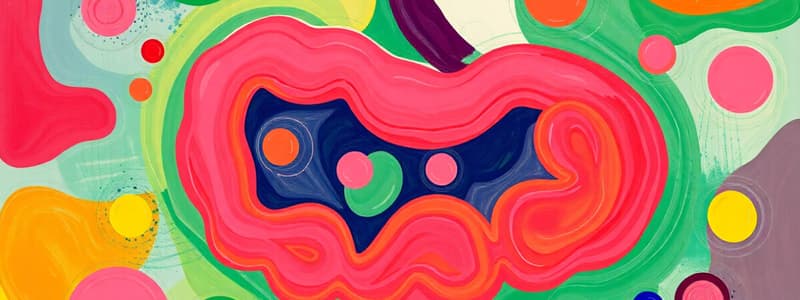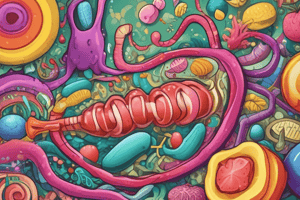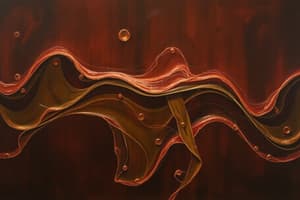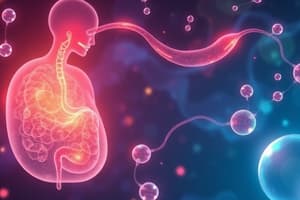Podcast
Questions and Answers
What is the primary role of acid lipases in neonates?
What is the primary role of acid lipases in neonates?
- They play a crucial role in lipid digestion. (correct)
- They are involved in the synthesis of pancreatic enzymes.
- They facilitate the absorption of water-soluble vitamins.
- They regulate calcium metabolism.
Which of the following best describes cystic fibrosis?
Which of the following best describes cystic fibrosis?
- An autosomal recessive disorder caused by mutations in the CFTR gene. (correct)
- A dominant disorder caused by excessive chloride secretion.
- An autosomal recessive disorder affecting sodium channels.
- A condition that exclusively affects pancreatic enzyme production.
What consequence results from defective CFTR in cystic fibrosis patients?
What consequence results from defective CFTR in cystic fibrosis patients?
- Decreased secretion of chloride and increased sodium reabsorption. (correct)
- Increased secretion of sodium and water.
- Enhanced absorption of fat-soluble vitamins.
- Improved hydration of pancreatic secretions.
How do bile salts assist in lipid digestion?
How do bile salts assist in lipid digestion?
What is a common treatment for managing cystic fibrosis?
What is a common treatment for managing cystic fibrosis?
What is the primary role of lingual lipase in lipid digestion?
What is the primary role of lingual lipase in lipid digestion?
Which statement best describes the function of lipids in the body?
Which statement best describes the function of lipids in the body?
What types of dietary lipids primarily make up more than 90% of the lipid content?
What types of dietary lipids primarily make up more than 90% of the lipid content?
How do gastric lipase and lingual lipase differ in their activity?
How do gastric lipase and lingual lipase differ in their activity?
What health issues are associated with imbalances in lipid metabolism?
What health issues are associated with imbalances in lipid metabolism?
Flashcards
What are lipids?
What are lipids?
Lipids are a diverse group of organic molecules that cannot dissolve in water. They are crucial for various bodily functions, including energy storage, cell membrane formation, and hormone synthesis.
Where does lipid digestion begin?
Where does lipid digestion begin?
The digestion of lipids begins in the stomach, where two lipases work to break down fats: lingual lipase and gastric lipase.
What is lingual lipase?
What is lingual lipase?
Lingual lipase is an enzyme found in saliva that starts the breakdown of triglycerides, especially those with shorter or medium-length fatty acid chains, like those in milk fat.
What is gastric lipase?
What is gastric lipase?
Signup and view all the flashcards
What is the optimal pH for lingual and gastric lipases?
What is the optimal pH for lingual and gastric lipases?
Signup and view all the flashcards
What is cystic fibrosis?
What is cystic fibrosis?
Signup and view all the flashcards
How does defective CFTR cause pancreatic insufficiency?
How does defective CFTR cause pancreatic insufficiency?
Signup and view all the flashcards
What is the treatment for cystic fibrosis?
What is the treatment for cystic fibrosis?
Signup and view all the flashcards
What is emulsification?
What is emulsification?
Signup and view all the flashcards
What is the role of pancreatic lipase in lipid digestion?
What is the role of pancreatic lipase in lipid digestion?
Signup and view all the flashcards
Study Notes
Biochemistry and Nutrition - Lipid Chemistry
- Lipids are a heterogeneous group of water-insoluble (hydrophobic) organic molecules
- Lipids can be extracted from tissues using nonpolar solvents
- Lipids are a major source of energy for the body
- The digestive pathway of lipids begins in the stomach
- Lipids are important for creating a barrier for the aqueous content of cells
Lipid Digestion and Objectives
- Objectives: Explain the digestive pathway of lipids, discuss hormonal regulation of lipid digestion, and understand cystic fibrosis
- Explain the digestive pathway of lipids in the stomach.
- The digestion of lipids begins in the stomach, catalyzed by lingual lipase (glands at the back of the tongue) and gastric lipase (secreted by the gastric mucosa).
- These enzymes are acid-stable, with pH optima of 4 to 6
- Explain how these enzymes work on short- or medium-chain length fatty acids like milk fat
- Explain how these enzymes work to break down molecules containing fatty acids
Lipid Digestion in the Pancreas and Intestines
- Lipase, assisted by colipase, is secreted by the pancreas to digest lipids
- Colipase anchors lipase to the lipid-aqueous interface, restoring lipase activity when inhibited by bile acids
- Orlistat, an antiobesity drug, inhibits gastric and pancreatic lipases, decreasing fat absorption and leading to weight loss
Lipid Degradation
-
TAG degradation:
- Pancreatic lipase preferentially removes fatty acids at carbons 1 and 3.
- Hydrolysis products include 2-monoacylglycerol and free fatty acids
-
Cholesteryl ester degradation:
- Most dietary cholesterol is free (nonesterified).
- Cholesteryl esters are hydrolyzed by pancreatic cholesterol ester hydrolase (cholesterol esterase) to form cholesterol and free fatty acids.
- Bile salts increase cholesterol ester hydrolase activity
-
Phospholipid degradation:
- Pancreatic juice contains phospholipase A2, an enzyme activated by trypsin.
- Phospholipase A2 removes one fatty acid from carbon 2 of a phospholipid, requiring bile salts for optimal activity
Lipid Absorption
- Free fatty acids, free cholesterol, and 2-monoacylglycerol are primary products of lipid digestion.
- Bile salts and fat-soluble vitamins (A, D, E, and K) form mixed micelles
- Mixed micelles are disk-shaped clusters of amphipathic lipids, with hydrophobic groups inside and hydrophilic groups outside.
- These micelles are soluble in the intestinal lumen
- These lipid particles are absorbed by the brush border membrane of the enterocytes (mucosal cells)
Lipid Malabsorption
- Lipid malabsorption results in increased fat in the feces, called steatorrhea
- Steatorrhea can occur due to disturbances in lipid digestion or absorption
- Conditions like cystic fibrosis (CF) and shortened bowel can cause lipid malabsorption
Control of Lipid Digestion
-
Cells in the lower duodenum and jejunum secrete a peptide hormone called cholecystokinin (CCK) in response to lipids
-
CCK acts on the gallbladder to contract and release bile, and it also stimulates the exocrine pancreatic cells to secrete digestive enzymes
-
Secretin, another peptide hormone, regulates pancreatic secretion in response to acid in the duodenum
-
Secretin stimulates the pancreas to release bicarbonate-rich solutions, neutralizing the acidity of the intestinal contents
Other important notes
- The diagram on diagram page 27 illustrates the key steps in lipid digestion from the gallbladder to the small intestine and its absorption into the cells.
- The diagram on diagram page 21 shows lipid digestion and absorption, including the formation of chylomicrons for transport
Studying That Suits You
Use AI to generate personalized quizzes and flashcards to suit your learning preferences.




